Greg Specht Interview
Author notes: - I originally contacted Greg in 2013. We messaged back and forth over the years casually up until 2023.
I've collated all of our conversations and edited text where appropriate for legibility. It's more a stream of consciousness than an interview. I apologize if it's harder to read as a result of this.
When I first spoke with Greg, I sent him the following screenshots of his former backstage area from the Dreamscape known as Goldfingers Lab. I was hoping this would be a good conversation starter.
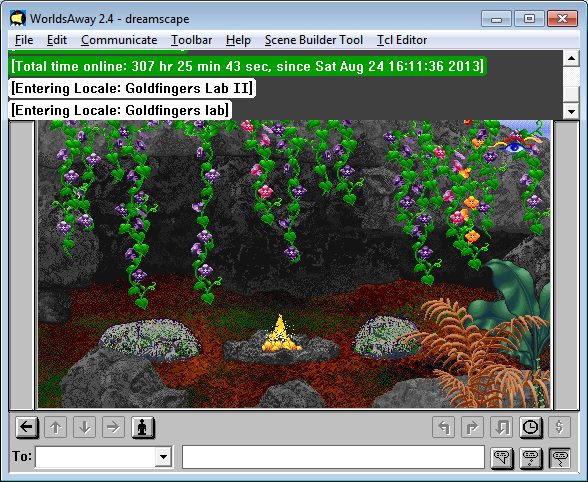

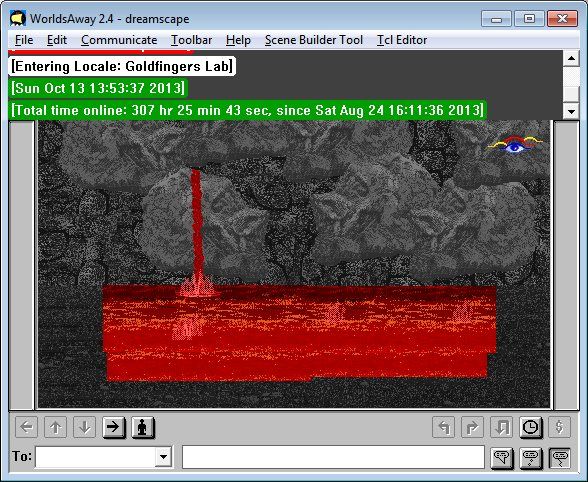
Greg: So the Dreamscape is still up and running in 2013? I was wondering if newer computers would run the software.
I did have an area where I experimented on a few locales I wanted to put in at some point. There was a locale that had lots of multicolored crystals along with waterfalls. Does that still exist? It was my favorite locale but I don't remember if I took it apart. It might be the one with the lava.
Its funny WorldsAway is still going. It had such potential, it's sad it went the way it did. Working for Fujitsu was the best job I ever had. I became Lead Animator and World Builder. We had a great art department.
To this day, I'm friends with a couple of people who worked there. In fact I just had to laugh, right now I'm actually wearing a T-shirt I got at one of their annual anniversary parties. Working there was a wild ride. The whole Silicon Valley was exploding during that time 1995 - 2000. Lots of stories.
It was at this point, I asked Greg a bunch of questions and instead of just replying to each one, he wrote down a sort of condensed timeline of his history as a WorldsAway team member.
Greg: I started at Fujitsu in April of 1995. I was told about the project by my fellow graduate and friend of multimedia school George Chiu. He had started there back in December of the previous year. He was known in Dreamscape as Artist 007. I still keep in touch with him as well as the other graduate who had gone to our multimedia school that I met at Fujitsu that day. Joe Zona, otherwise known as Artist Brimble. I was hired to process art. I didn’t draw 2D. My passion was 3D and they had thoughts of going 3D in the future so on top of Georges recommendation they liked me for that.
In the beginning, George was in charge of processing avatars. He also did the double click animations for the first avatars. Joe (Artist Brimble) focus was on processing and drawing. I think the first animation they gave me was the birdbath. They liked what I did so much that from then on I did most of the animations. Later I took on processing the avatars and doing their double click animations for them as well. George moved onto scene building and did most of the core of the town. Later I moved into scene building and my main contribution to Dreamscape (as far as I can remember off hand) is I did all of the Jungle. (I also did the Dreamscape 3 story V store? Club Caribe, (the toucan in the front room I animated) and the Magic Shop. One of the few drawings I did is the Victorian house which was mostly used as a haunted house.
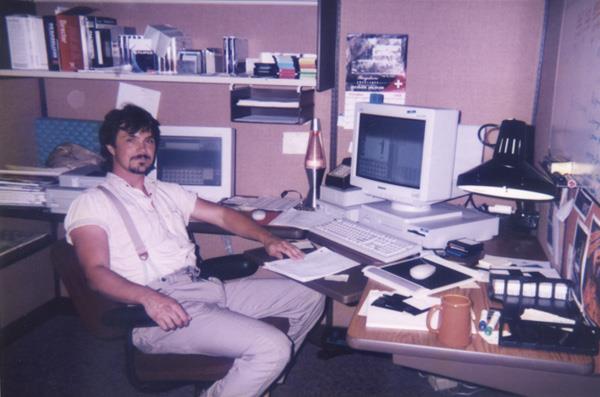
Greg: Sheryl Knowles was our art director. She was an awesome person and old timer in the industry who started back at Amiga. Our art department was just as they described it. We left the harsh overhead fluorescents off and just illuminated the room with our desk lamps and the light from our computer screens. We could come and go as we pleased. I’d come in at 11 am. Work for a bit, (or surf the net) then go to lunch. After lunch was the daily walk along the Guadeloupe Creek.
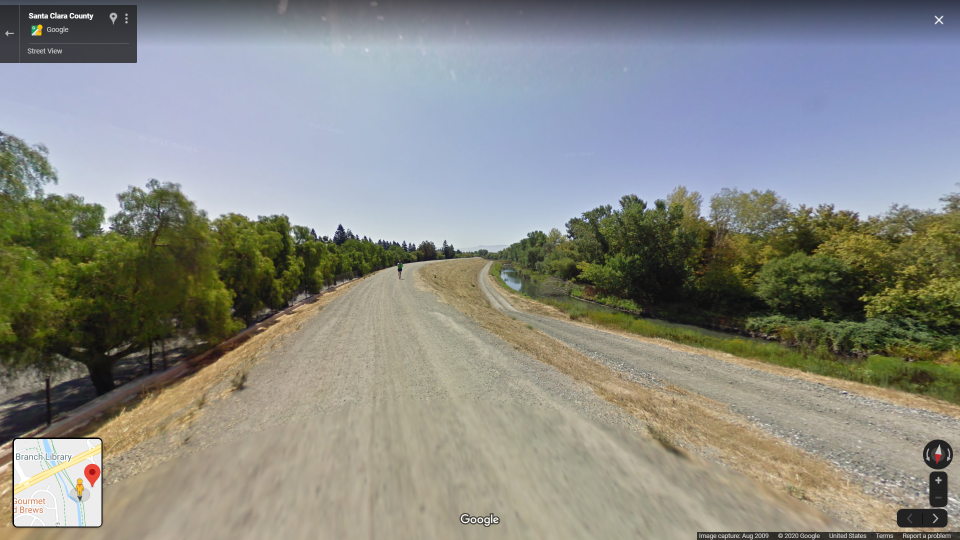
Then we’d buckle down and work until 5 or 6 (when Sheryl would go home) and then several guys from the different departments would get together and play Duke Nukem until 8 or 9 at night. Then we’d go home. How cool is that??!!! Best job EVER! Some nights we’d work on projects late in order to meet the deadlines. Those hours were great because traffic was so bad in the valley that a 20 minute ride to the office at 11 am was an hour and a half at 7:30. Same thing at night. You did not want to be on the road between 3:30 to 6:30 pm.
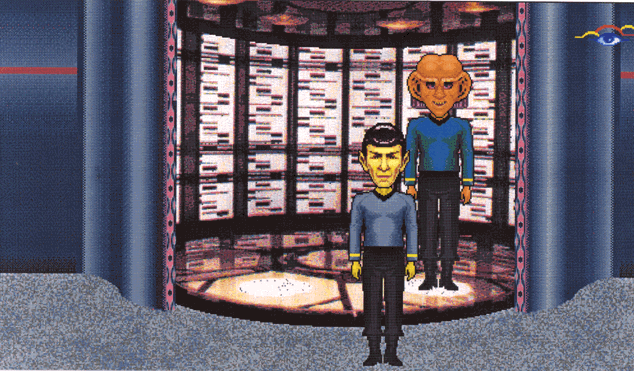
Greg: Yeah, I remember the Paramount project. We were very excited about it. Of course it never went anywhere. The politics at Fujitsu could be the subject of an entire book. The head of our division actually wanted us to FAIL. There was a power struggle between different factions and we were pawns in that. Long story.
I kept ALL the artwork. From the beginning of my involvement I noticed that the volume of work was becoming crazy so I took it upon myself to archive and catalog it using thick 3 ring binders. In the end it helped me start up the naked avatar project and continue on for 3 more years after the company had crashed and burned under the venture capitalist debacle. I had taken all the artwork files home with me and had told the guy who had server knowledge and was a fan who wanted to keep it going that I had a set of naked avatars that had never been released and they might be a good source of generating income. Those next 3 years are another story….
Author notes: The guy Greg is referring to here regarding the naked avatars was Robert Dunbar, who was initially a remote assistant for Fujitsu and later took over operations of the worlds entirely, saving them from being shuttered. Robert commissioned Greg to complete these avatar bodies, paying him close to $7000, with $3000 down and the rest paid as the artwork progressed. These naked avatar bodies would later be used in the Seducity virtual world aimed at adults that was launched in 2001.
Greg: I still have all the artwork files up until I was forced out. I have copies of the original Dreamscape map drawn by Joe and some other things. Anyway, that’s a quick history.
We spoke some more and Greg shared this.
Greg: I got a little story for you to highlight how frustrating it was to work there. I have the original CD demo of WorldsAway that was given to CompuServe customers to give them a preview of what WorldsAway was going to be. In it it showed avatars beaming in and out of the transporters just like in the original Star Trek. The avatars would dissolve into particles and reconstitute at the other end. It was so cool. As the project got closer to its first release, I started asking about implementing that feature because (being a bit of a nerd ) I thought that feature was one of THE coolest aspects of the software. In the product as it was about to be released the avatar just vanished and reappeared. I was told they didn't have the time to write the code to make it work. It was supposed to be very difficult. It was my first inkling that management didn't have a clue what made the software attractive. But in all fairness they were having trouble getting the software to run at all. In fact I remember the team begging to not launch the product because it ran SO SLOW.
I remember people were so excited. They couldn't wait!!! We'd get letters from people regularly just drooling over the thought that this software was coming. When it finally opened to the public I remember a customer, barely able to more or do anything, only a dozen or so locales were even open, facing the screen, his avatar shrugged and the talk balloon said - "I waited 3 months for THIS???!!! I felt so bad. It was so embarassing. Anyway, years passed. The teleport animation was never given the green light. At one point they did implement the avatar spinning around before it vanished but it was still lame.
During this period, a young guy in QA was discovered who could write TCL code and he was good! I think his name was David. I don't remember anymore. When we were sold to the venture capitalists, he was the lead programmer. A year in, I ran the idea by Sheryl again. David was there and as we talked about it I asked him how long did he think it would take to program. He said A DAY AND A HALF!! I couldn't believe it. I begged Sheryl to make the dissolve sequence art and David said he would take a few hours and see if we could get something going. He did, I processed the sequence, we put it into a test world and low and behold an avatar dissolved and disappeared. It was sooo cool looking!!!! David said he could work on it - there were issues with what the "client" computer user would see with multiple people using the teleport at once, timing issues and such, roughly a days work. They wouldn't allow him to finish it!!!!! I couldn't believe it. Idiots.
We also did a little work on true vehicles! David adapted the chair object class and avatar walk sequence and got a horse to walk across a locale. He only needed permission to finish it so that a "chair" could leave one locale and enter another. Again, the management would not give him the time to do it. They were too busy having him do stupid "business to business" bullshit that was never going to sell. Could you see high end executives having meetings using avatars? I don't care if the avatars are dressed in suits it was stupid. Anyway it was around this time that Sheryl quit and the company was entering its downward spiral.
In retrospect before David took over we had really crappy coders. Its understandable, it was during the dot com boom, coders worth anything were worth their weight in gold. The software itself was a patchwork quilt written by dozens of people. The whole thing needed to be rewritten from the ground up. And that is what WorldsAway 3.0 was supposed to be. That sad story is for another time....
P.S. I forgot to say the avatar STEPPED INTO THE TELEPORTER and then dissolved!!!! Complete with a teleporting sound effect (which had been sitting around waiting to be put in) The light on top of the teleporter flashed on and off. Animation that had been coded into the teleporter art file but never connected to code so it would function. It was a beautiful thing to behold.... it still makes me sad and grind my teeth!
Greg: The animation was on the teleporter. You have to layer the programming tag that the avatar walks to behind the dissolving animation art, which also is behind the outer shell of the porter. Sheryl built a fatter version of the teleport to fit some of the larger heads. Your CompuServe preview is a lot like mine, most of it is the same. At the end of mine is the picture of a 4 armed robot standing in front of a teleporter shaped like a strange viewport looking out onto a planet floating in space.
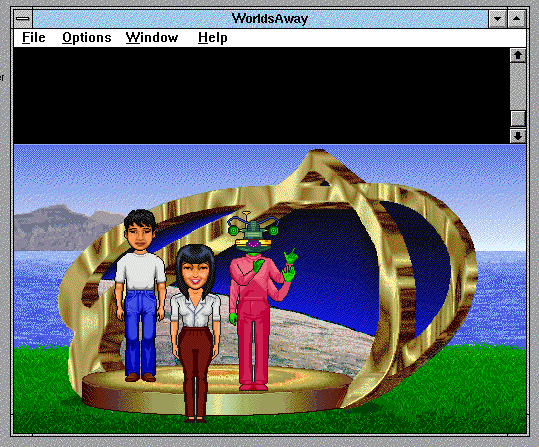
Greg: WorldsAway version 3.0 was actually specced to be pretty cool. Lots of cool features, and it had a new interface. I don't remember what they were anymore bit it was impressive and when it was presented to us we were excited. But then something happened. The marketing team had some potential customer they wanted to hook so our fearless leaders told David to just connect up the new interface to the old software with a couple of features added that were done so they could show it to the potential customers. David and the rest of us were SO PISSED. I don't remember if management hooked the client. If they did they only signed up for a short contract and then dumped us when it became obvious we didn't deliver what we had promised. Either way, they took that half assed upgrade and decided to leave it at that. Calling it 3.0 and putting David back to patching in little bullshit stuff.
We all knew it was a lost cause then. At least that's how I remember it going down. I remember the Canada guys. We were in the new building in Santa Clara when they came down to collaborate after the venture capitalists bought us. Getting the new building was also a disaster. It was so important for the transition to be smooth. We needed high end internet connectivity ready to go. The person who was responsible for picking out the building was clueless. The building had NOTHING. We had to install it all from scratch. It took over a month. Us in the art department got a week off while they got things up and running for us. Once we got up and running we managed to hire Artist Brimble back. He ended up being the last to leave, a week or two after I was laid off in mid 2000.
WorldsAway never had anyone in charge who had a clue. None ever spent time in the Dreamscape because they liked it. The company was always run by marketing sharks.
I mentioned to Greg that I had tried to contact some other WorldsAway team members but they didn't respond. This is his take on why they may not have.
Greg: When you first contacted me it was just a friend request from someone I had never seen before. I get those all the time but usually from cute girls. I don't know what is up with that. Anyway I didn't answer until you attached a message to it telling me why you were contacting me. It is also possible that the other people you contacted may just not want to talk about WorldsAway. Our WA team loved the product and our job and we were all such good friends it is quite a bitter pill to have had it die like it did.
Artist Mischa, I think her name was Julie Ramirez. (I'm really bad at remembering names) I haven't seen her since about a year after we all left. We were good friends and we invited her a couple of times when we - Lambert Ma, George Chiu, Joe Zona, and Vaz would get together but she always had an excuse. I don't think I have her number anymore. Her and Sheryl are close friends but Sheryl also never showed up to get togethers. We all did get together once about a year or two after it collapsed but that was the last and only time a bunch of us got together. It was one of the teams engagement party.
Some time elapsed between conversations. I had been doing research on a world named 'WebWorld' which had been mentioned in Fujitsu press releases. I showed Greg some of the following screenshots.
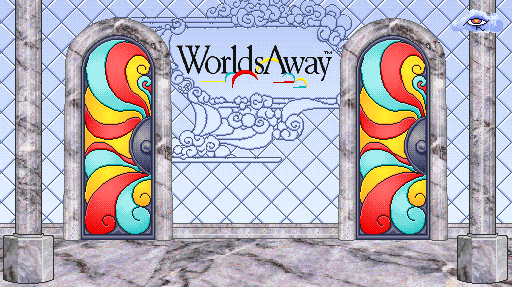
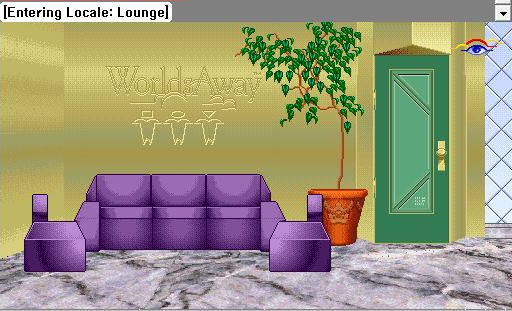
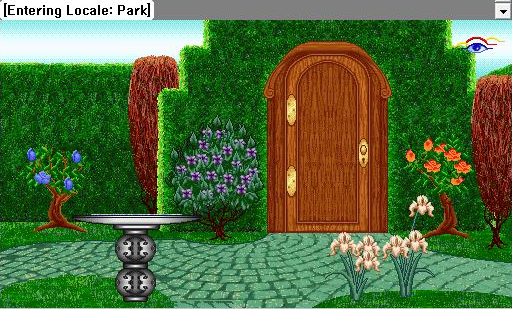
Greg: I remember these. I built the lobby locale in the first picture. I know that. Infact, I built all of the regions for it. But I don't remember what WebWorld was for. Was it built as a sort of square that you went around? I would think it was just another demo to show a prospective client highlighting what WorldsAway could do... That's my best guess.
You can tell that the deal must have fell through (like they all did) because three of the locales you showed me aren't finished. Those are Theatre, Interior Arcade and Arcade 2.
Sheryl drew the artwork pieces in the first image you sent me. Beautiful stuff. The door glass are color replaceable so that we could use any color combination for staining. This would be a fitting entrance for WorldsAway. Better than the fairly dull one that you go thru after the Argo intro.
We briefly touched on Hotel Silicon and I showed him a map of the world captured by my friend Metal Edd.
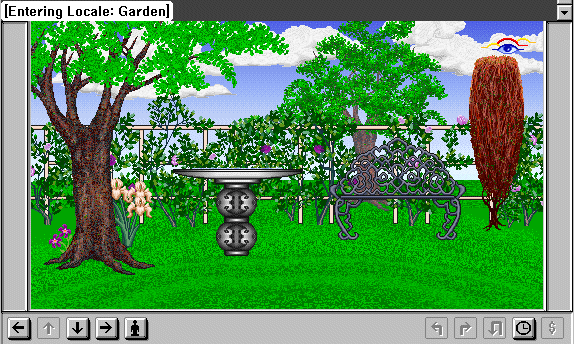
Greg: I may have built those regions. The outdoors locale looks like my work. A couple of interiors I don't recall at all. They were pretty basic so I might have whipped them out without thinking about them much. I remember the artwork though, I did process a lot of it and I also animated the guy behind the desk (the Turf Manager).
I asked Greg if he ever kept the binder with the artwork he mentioned earlier, amongst other things.
Greg: I did not take the binder with all the WorldsAway art. I left it with Joe, being he was the last to still be employed by the venture capitalists. I really doubt he thought of any reason to take it when he was laid off and keep it. As for the the other files you enquired about, I'm afraid I can't bring myself to go digging to find that stuff. Even after 10 years there is still a bad taste in my mouth about it. Sorry.
I was very grateful to Greg for sharing anything with me, information or otherwise. I totally appreciated where he was coming from and didn't wish to bug him. He assured me it wasn't bugging him and shortly after this conversation, he found and sent me an original WorldsAway mouse pad.
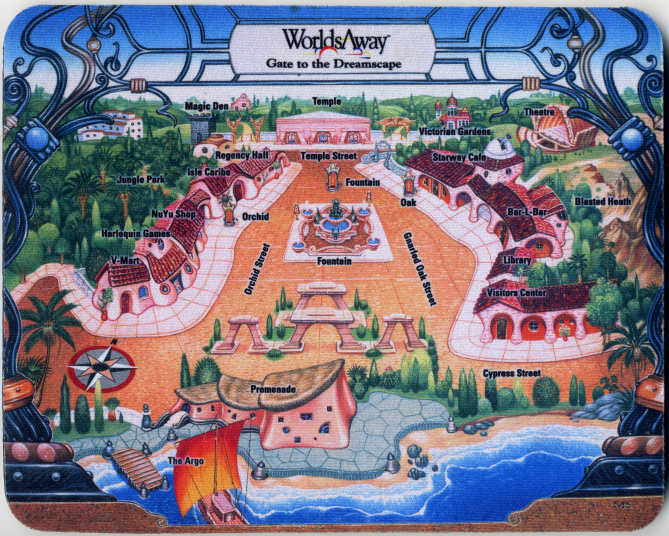
I asked Greg about the map featured on the mousepad and if he knew who created it.
Greg: Joe Zona did an original that was released to the customers. It was used for a while. Hidden on it is my name and our other artist George Chiu's name. Boy did we get in trouble by our supervisor when she found out! We felt like the Disney artists who would throw in genitals for a frame or two in some of their films, like Roger Rabbit. After a few weeks the company hired an outside firm to make the "remake". I don't know who they were. Its the only thing they did for us that I know of. I have a mouse pad with that original artwork as well as a small poster of it (which I won't part with).
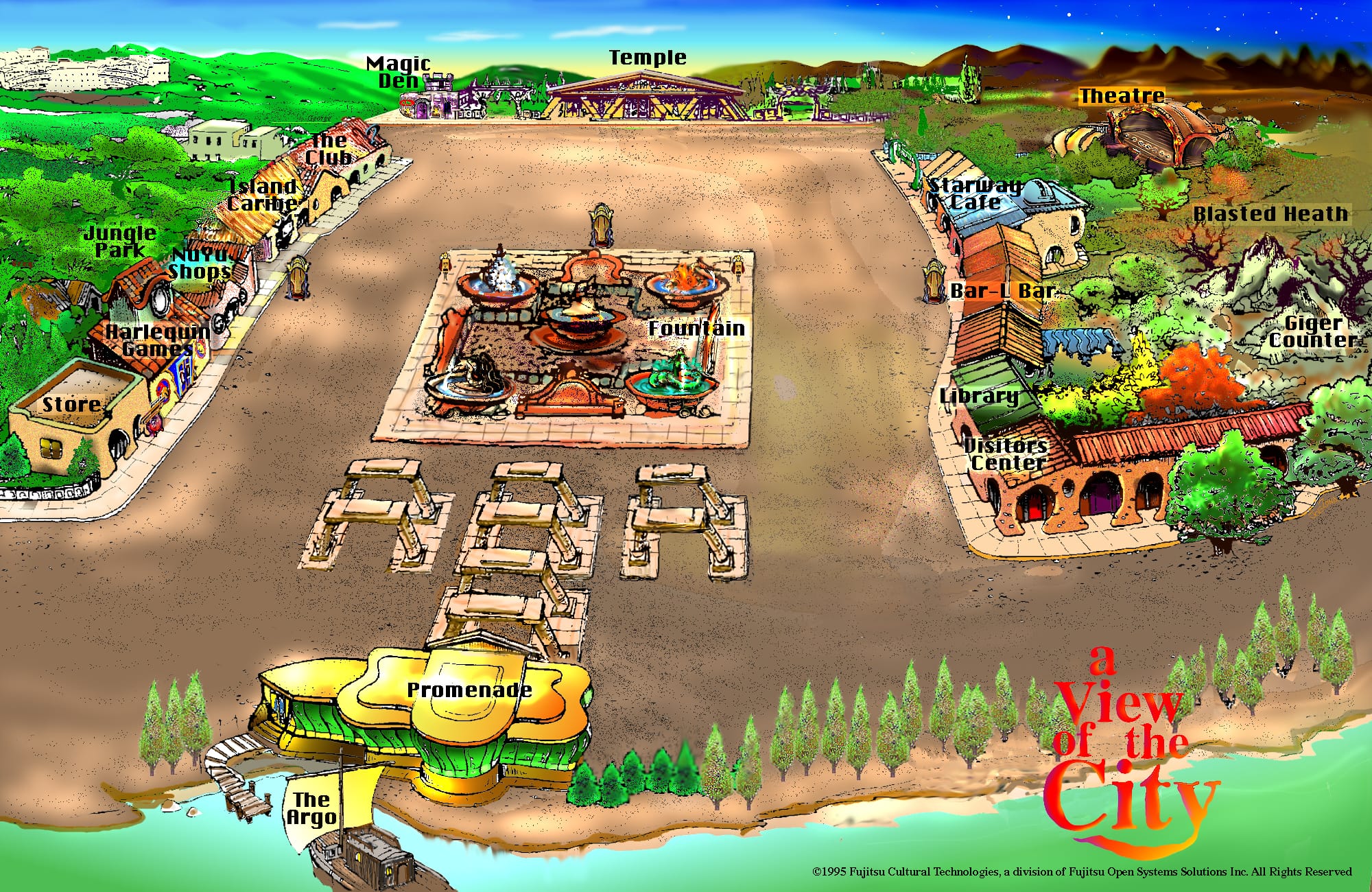
I asked Greg if this was the original map Joe Zona drew.
Greg: Yes. If it's the first version, our names are in the bottom right quarter.
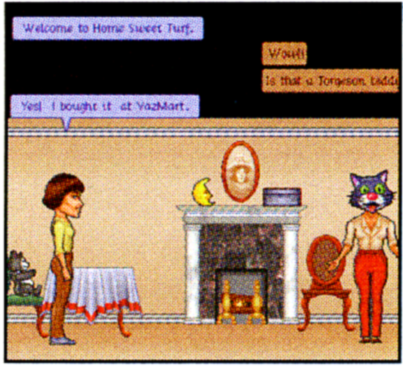
This screenshot was featured in an early CompuServe advert from Compuserve Magazine - March 1996, kindly scanned, cleaned up and shared by Benj Edwards. I showed this to Greg and asked him if this was just concept art, or the actual client in development.
Greg: Yes, I think it was a mock up. At least the locale was a screen grab and then the words were put in after. It all has to be made into higher resolution for print, so they may have just put in the text at high res so they didn't have to do it in photoshop.
I asked Greg if when they were designing locales for Fujitsu, did they ever draw them out on paper beforehand? Like storyboarding. How was a region put together back then?
Greg: It sort of evolved over time. In the beginning we were given mockups but latter on we got to improvise a lot more. Sheryl, our Art Director would either draw the art pieces or get Joe to, and then give us the specifics as far as how each locale was to connect to the rest of Dreamscape.
Sometimes things like pictures of building fronts would still be provided so we could reproduce them from the pieces. On the Jungle and V-Mart, I was told what was generally needed and I basically drew out how the string of locales would go together, and once okayed was allowed complete freedom as far as design. There would be new art provided and I would put them in as I saw fit.
Sometimes I would sketch out how each locale would look on a sheet of paper just to get things rolling. Most often a new piece of art made for that section would just spark an idea and if I needed a piece of artwork for that that we didn't have, Sheryl or Joe would often draw it for me. Rarely I would do it myself, I'm not that good at drawing.
I drew the carnivorous plants for the jungle because I wanted to put those in and Sheryl okayed that. Mostly, when building a locale I would put in the basic background (such as walls, doors, other essentials) and just play around with pieces until an idea would pop in.
I asked Greg if he remembered if there were any official guidelines on drawing artwork.
Greg: Sheryl and the other artists used a program I think was called D-paint. The main point of it being you could set it up so you would be drawing in whatever 256 color palette you had chosen. Other than that there were things like schematics for maximum head size, and templates for coding marker guides for things like creating hats that would fit on most heads.
Greg discovered a picture of his original lab, prior to him destroying it upon his depature.
Greg: Hey, I found a picture I took of Goldfingers lab before most of it was deleted. From what I see that you have, all that is left is a lava waterfall and rock. I was mad when I left. It's my favorite locale that I designed and I didn't want them to have it. The crystals were a Sheryl design.
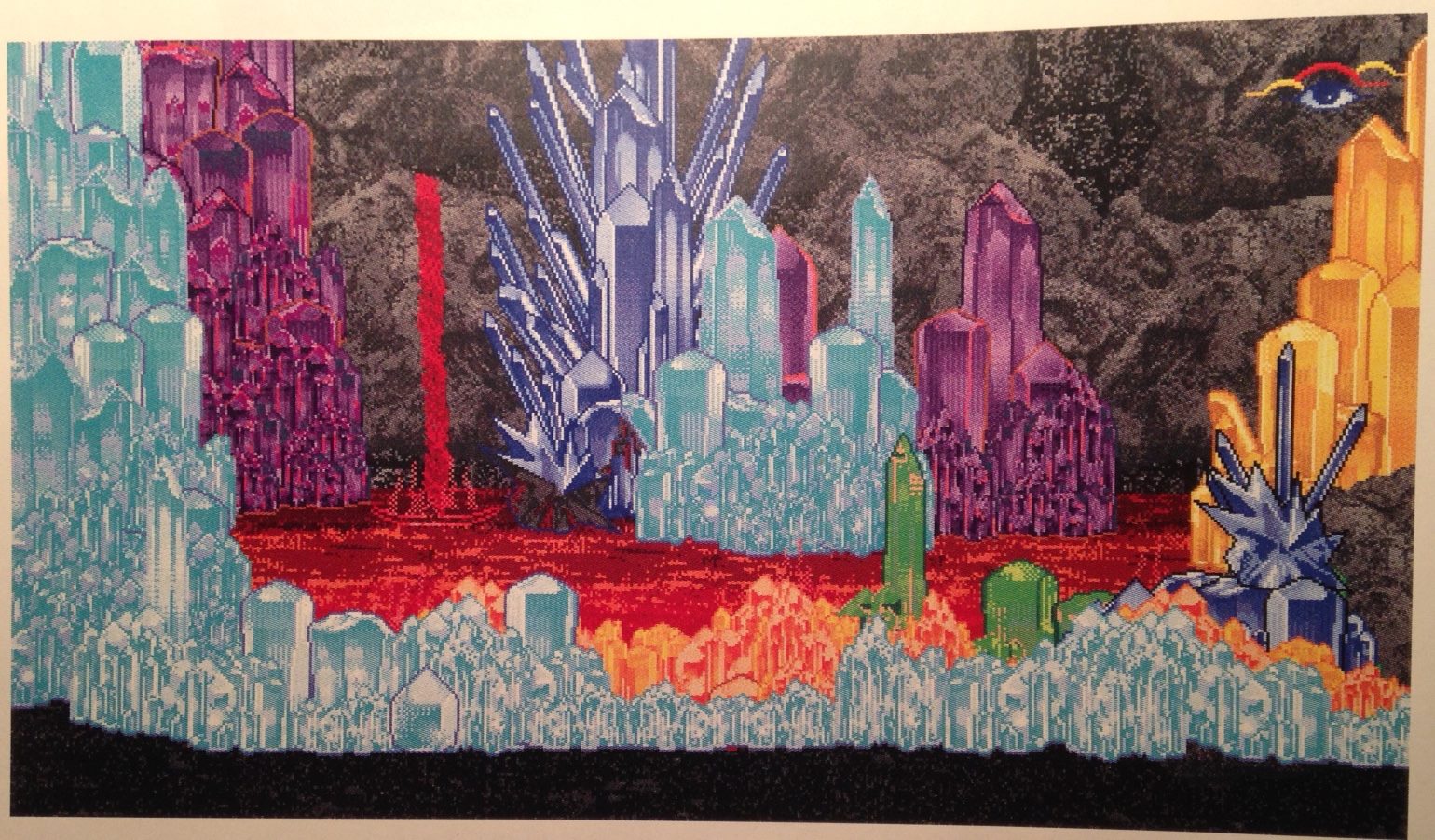
Seeing the original lab, it jogged my memory and made me think of the Magic Shop regions when they first opened. They featured a similar crystal cavern. I mentioned this to Greg.
Greg: Well, I built the Magic Shop so I guess my style of creativity betrays itself. The Magic Shop was one of the last things Sheryl and I put together before she left. It was a pretty ugly and tumultuous time.
I asked Greg about which version of V-Mart he built and other regions he created.
Greg: I built the newer V-Mart with the elevators. I built all of Club Caribe, the whole Jungle, the Magic Shop, I did the art for the Victorian Mansion,.... well, looking at the map I built most of the interiors of most of the places. For the most part, Joe and Julie did art and processed, George built avatars and processed, and did the early double click moves. - the standard male and female, the buffed male and the chubby male.
George also did many of the early outdoor locales that made up the streets. I processed, did almost all animations of objects, processed the later avatars, and did their double click moves, and did most of the world building. Julie tried to do one animation, that of a juggler, but it looked bad. I don't know if it went in.
The juggling balls didn't have any acceleration/deceleration in them. I made a frame by frame sketch for Julie to show her how to do it but she just couldn't understand what I was talking about. They just circled around at constant speed.
Finally, I asked Greg about Pride and his memories of the place.
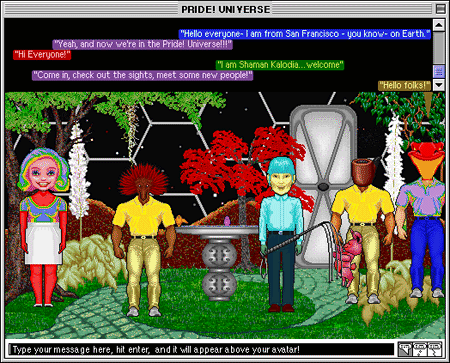
Greg: Yes, does it have a central sort of glassed in hub? I built that.